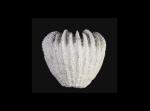|
An invertebrate is an animal without a backbone.
This group includes 95% of all animal species.
Because
of their large numbers and great diversity I've arranged the phylum mollusca by class.
Typically the phylum is divided into seven classes.
The New Jersey fossil record provides us with examples from four of the
seven classes.

Phylum: Mollusca (Linnaeus, 1758)
Mollusks have more varied forms than any other
animal phylum. Despite this amazing diversity, all mollusks share some
unique characteristics. The body has a head, a foot and a visceral mass.
This is all covered with a mantle that typically secretes the shell. In
some groups, like slugs and octopuses, the mantle is lost, while in
others, it is used for other activities, such as respiration.
Class: Gastropoda
(Cuvier, 1795)
 |
Common
name - gastropod
Gastropods are one of the most diverse groups of animals
and by far the largest group in the mollusca phylum.
|
Class: Bivalvia (Linnaeus, 1758)
 |
Common
name - clam
Clam is a common name for several kinds of bivalve molluscs.
The term is often applied only to those that live partially
buried in the sand.
|
 |
Order:
Ostreoida (Férussac, 1822)
Common name - oysters
The oyster shell is made up of two unequal valves, the
upper one flat (right) and the lower convex (left).
|
 |
Order:
Pectinoida (Gray, 1854)
Common name - scallop
One of very few groups of bivalves to be primarily
free-living, with many species capable of rapidly swimming
short distances
|
Class: Scaphopoda (Bronn,
1862)
 |
Family: Gadilidae (Stoliczka, 1868)
Family: Dentaliidae (Children, 1834)
Common name - tusk shell
Marine molluscs with a tapering tubular shell, that is open at both ends.
The class scaphopoda is represented by only two families, |
Class: Cephalopoda (Cuvier
1798)
 |
Order: Belemnitida (Gray, 1849)
Common name - belemnite
Very similar in many ways to the modern squid and closely
related to the modern cuttlefish. In New Jersey the
belemnite guard is usually amber colored, due to absorption
of iron.
|
 |
Order: Ammonitida (Hyatt 1889)
Common name - ammonite
Ammonites are perhaps the most widely known fossil,
typically possessing a spiral-type shell.
|
 |
Order: Ammonitida (Hyatt 1889)
Family: Baculitidae (Gill, 1871)
Genus: Baculites (Lamarck, 1799)
Common name - baculite or walking stick
Baculites are a straight shelled type of ammonite
|
invertebrates continued
|














